More people are turning their outdoor areas into welcoming spaces for birds. This trend combines ecological stewardship with the joy of observing wildlife up close. By making a few thoughtful changes, you can create a habitat that supports various species while enhancing your garden.
Strategic planning is key. Incorporating native plants, water features, and shelter options can transform your yard into a year-round haven for birds. According to recent data, 96% of land birds rely on insects to feed their chicks, making native vegetation essential1. Additionally, providing shallow, shaded water sources can attract even more species2.
With over 40 million acres of U.S. lawns that could be converted into bird-friendly spaces, the potential for positive impact is significant1. Simple steps like adding feeders, planting native flowers, and creating safe nesting areas can make a big difference.
Key Takeaways
- Native plants provide food and shelter for birds throughout the year.
- Water features like birdbaths attract a variety of species.
- Strategic landscaping enhances both wildlife support and curb appeal.
- Seasonal adjustments ensure birds have what they need year-round.
- Small changes can transform your yard into a bird-friendly habitat.
Why Create a Bird-Friendly Backyard?
A bird-friendly environment brings ecological and personal rewards. By attracting birds, you contribute to a healthier ecosystem while enjoying the beauty and activity they bring to your garden.
The Ecological Benefits of Attracting Birds
Birds play a crucial role in natural pest control. They consume millions of insects, reducing the need for harmful pesticides. In fact, native plant gardens can cut pesticide use by 80 million pounds annually3.
Native plants, like oak trees, support over 532 butterfly and moth species, which are essential food sources for birds3. This creates a thriving habitat for wildlife and promotes biodiversity.
Birds also help pollinate plants, ensuring the survival of 1,200 crops that depend on pollinators3. By fostering a bird-friendly space, you’re supporting a balanced and resilient ecosystem.
How Birds Enhance Your Gardening Experience
Beyond ecological benefits, birds add joy and tranquility to your outdoor space. Studies show that birdwatching can reduce stress by 41%, offering a relaxing escape4.
Incorporating native shrubs and plants not only attracts birds but also enhances your garden’s beauty. These plants require less maintenance and water, making them a sustainable choice.
By creating a bird-friendly area, you’re not just supporting wildlife—you’re transforming your garden into a vibrant, dynamic space that benefits both nature and your well-being.
Best Backyard Birding Landscaping Ideas
Transforming your outdoor space into a haven for birds starts with the right plants. Native varieties not only provide food and shelter but also create a sustainable ecosystem. By carefully selecting and arranging these plants, you can attract a diverse range of species to your garden.

Native Plants That Double as Bird Buffets
Certain native plants are particularly effective at attracting birds. For example, oak trees support over 532 butterfly and moth species, which are essential food sources for birds5. Bee balm is a favorite of hummingbirds, while purple coneflower provides a seed buffet for finches and sparrows6.
Other top choices include serviceberry, which offers berries for wildlife, and milkweed, which attracts insects and provides nesting material7. These varieties ensure your garden is a year-round food source.
Strategic Plant Clustering for Maximum Impact
Grouping plants together can enhance their effectiveness. For instance, cluster planting with native flowers and shrubs creates a bird-friendly habitat5. Sunflowers and coneflowers, when planted together, produce three times more seed than hybrid varieties, attracting seed-loving birds5.
An “island bed” design, featuring parsley and rocks, provides perching spots and shelter6. This approach not only supports birds but also adds visual interest to your garden.
Year-Round Blooms for Continuous Bird Support
To ensure birds have what they need throughout the year, plan for four-season blooms. Start with spring dogwoods, followed by summer trumpet vines and fall asters6. Winter interest can be maintained with evergreen plants like hollies and spruces7.
Feather reed grass is another excellent choice for winter, providing both shelter and aesthetic appeal6. By incorporating these plants, you’ll create a dynamic and supportive environment for wildlife year-round.
Choosing the Right Plants for Your Bird Habitat
Selecting the right plants can make your outdoor space a thriving bird habitat. Native trees, shrubs, and flowers provide essential resources like food, shelter, and nesting sites. By carefully choosing these elements, you can create a welcoming environment for various species.

Trees That Shelter and Feed Birds
Trees are the backbone of any bird-friendly garden. Oak trees, for example, support over 532 butterfly and moth species, which are vital food sources for birds8. Dogwood trees attract birds with their flowers and fruits, while also providing nesting sites8.
Other excellent choices include birch trees, which host caterpillars, and crabapple trees, which offer winter fruit9. These trees ensure your garden remains a year-round haven for wildlife.
Shrubs That Provide Nesting Sites
Shrubs are essential for creating safe nesting areas. Elderberry, with its dense foliage, is a favorite among many bird species8. Juniper provides evergreen cover and is particularly loved by bluebirds9.
Spicebush is another great option, offering fuel for fall migration9. Planting these shrubs in groups of three or more creates larger areas of cover, making your garden even more inviting10.

Flowers That Attract Hummingbirds and Pollinators
Flowers play a dual role in attracting hummingbirds and supporting pollinators. Cardinal flowers are a top choice, as their nectar increases hummingbird visits by 60%9. Milkweed is another excellent option, hosting monarch butterflies and providing nesting material for birds8.
For a vibrant mix, consider adding fuchsia and penstemon, both known as hummingbird magnets9. These flowers not only beautify your garden but also ensure a steady food supply for wildlife.
For more tips on creating a bird-friendly habitat, visit Mass Audubon’s guide.
Essential Water Sources for Thirsty Birds
Providing water sources in your garden is a simple yet effective way to support local birds. Whether it’s a birdbath or a natural feature, clean and accessible water can attract a variety of species while enhancing your outdoor space.
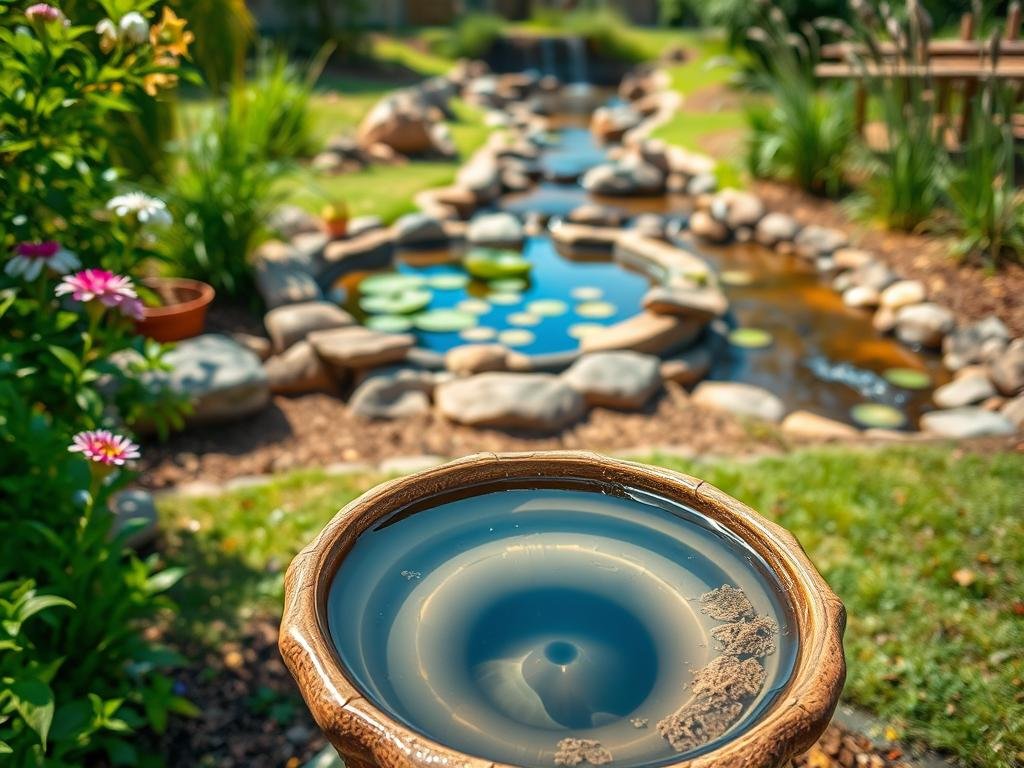
Birdbath Placement and Maintenance Tips
Choosing the right place for a birdbath is crucial. Elevate it about 3 feet off the ground to keep predators at bay. Position it near shelter, like bushes or trees, but ensure there’s open sightlines for safety11.
Shaded areas are ideal, as they reduce evaporation and keep the water cooler11. Regular cleaning is essential—use an electric toothbrush to clean feeder ports effectively12.
When selecting materials, consider concrete for stability, plastic for lightweight options, or copper, which naturally inhibits algae growth11.
Creating Natural Water Features
Natural water features like fountains or streams can be a stunning addition to your yard. Hollowed boulders are an excellent choice, as they reduce mosquito breeding compared to stagnant water.
Adding motion, such as a water-wiggler or fountain, attracts more birds and deters algae12. For a DIY project, try building a tiered fountain using basalt slabs for a rock garden effect11.
In winter, use a 50W aquarium heater to keep water from freezing, ensuring birds have access to liquid water when natural sources are scarce12.
- Elevate birdbaths to 3 feet for safety.
- Place water sources in shaded areas to reduce evaporation.
- Use materials like concrete, plastic, or copper for durability.
- Add motion to water features to attract more birds.
- Maintain clean water sources year-round, especially in winter.
Bird Feeders: More Than Just Seed Dispensers
Bird feeders play a vital role in supporting local wildlife, offering more than just seeds. They provide essential food sources and attract a variety of species to your garden. By choosing the right feeders and maintaining them properly, you can create a safe and welcoming environment for birds.
Selecting Feeders for Different Bird Species
Different birds have unique feeding preferences. Tube feeders are ideal for finches, while platform feeders attract cardinals. Suet feeders are perfect for woodpeckers, and nectar feeders are a favorite among hummingbirds13. Matching the right feeder to the species ensures they get the food they need.
Jelly feeders, for example, can boost oriole residency by 70%. When selecting feeders, consider squirrel-proof options to protect the seeds and ensure safety for the birds.
Keeping Feeders Clean and Safe
Regular maintenance is crucial for bird health. Clean feeders weekly with a 1:9 bleach solution, paying special attention to hidden crevices13. Labeling dedicated “bird brushes” can make this task easier and more efficient.
Avoid cheap seed mixes, as they often attract house sparrows. Instead, opt for black-oil sunflower seeds, which are preferred by 89% of bird species13. Proper placement is also key—position feeders 15 feet from windows and rotate locations to prevent ground waste13.
For more tips on choosing the best feeders, visit this guide.
Creating Safe Shelter From Predators
Protecting birds from predators is a key step in creating a safe outdoor habitat. By providing secure shelter, you can ensure their survival and encourage them to thrive in your garden.
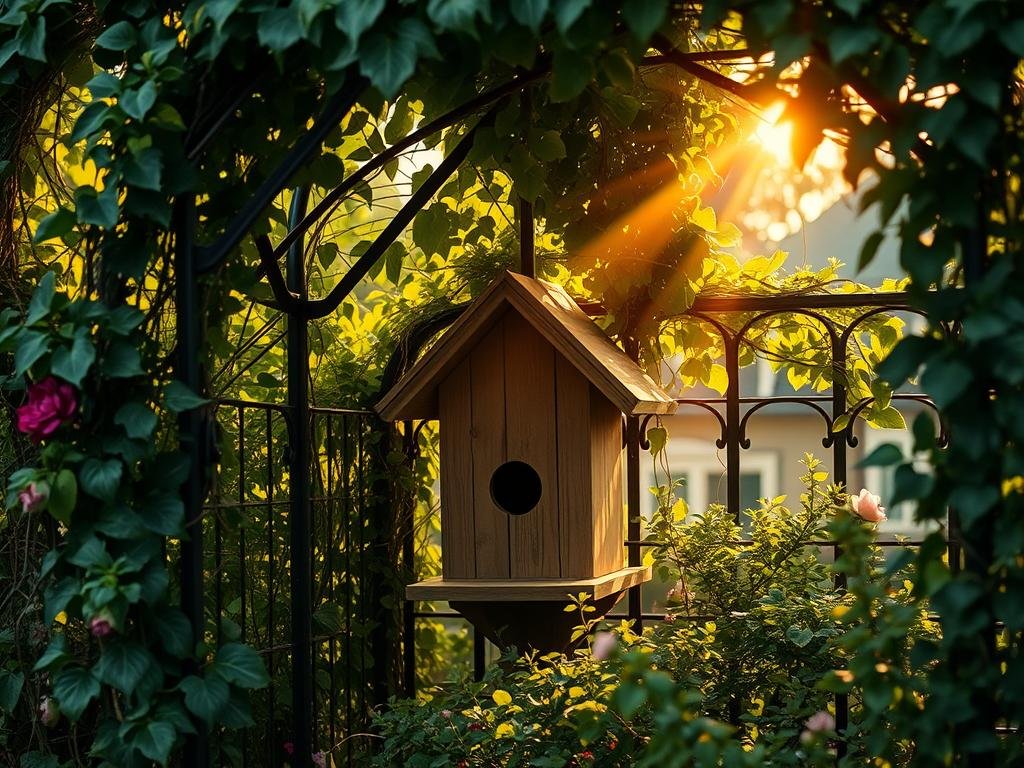
Dense Shrubs for Nesting Protection
Tall shrubs, like holly and arrowwood viburnum, offer excellent cover for nesting birds. These plants reduce nest predation by 40%, making them a vital addition to any bird-friendly space14.
Rugosa rose, with its thorny stems, adds an extra layer of protection against predators. Letting shrubs like lilacs grow naturally preserves nesting nooks and enhances safety15.
Strategic Placement of Birdhouses
Birdhouses should be placed in areas with ample cover, such as near dense shrubs or trees. For example, a “fence line garden” using blue spruce provides both shelter and aesthetic appeal16.
When installing birdhouses, ensure the entrance holes are species-specific—1.5 inches for bluebirds and 2.5 inches for screech owls. Angled roofs help with drainage and longevity14.
- Use holly, arrowwood viburnum, and rugosa rose for dense cover.
- Recycle Christmas trees to create instant winter shelter14.
- Build DIY brush piles with fallen branches and evergreen boughs15.
- Avoid over-trimming shrubs to maintain natural nesting areas16.
Low-Maintenance Tips for Busy Birders
Creating a low-maintenance space for birds doesn’t have to be time-consuming or complicated. With the right plants and tools, you can enjoy a thriving garden that supports wildlife while saving time and effort.
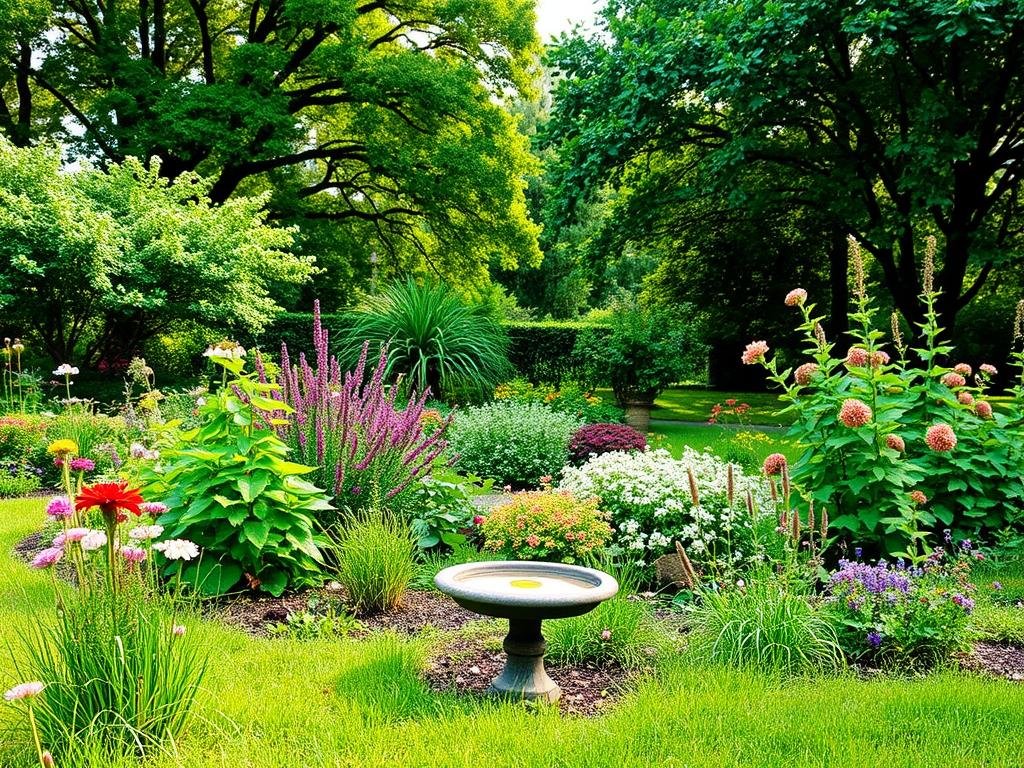
Drought-Resistant Plants That Birds Love
Native plants like blueberries and elderberries require less maintenance and provide essential food for birds17. These varieties are drought-resistant, making them ideal for busy gardeners. For example, blue fescue and lamb’s ears thrive with zero additional water, ensuring your yard stays vibrant for months17.
Other drought-tolerant stars include yucca, which produces seed pods, and sedum, which offers late-season nectar. Blue oat grass is another excellent choice, providing nesting material for birds18. These plants not only support wildlife but also reduce the need for frequent watering and care.
Automated Watering Systems
Installing an automated water system can save time while keeping your garden hydrated. Drip irrigation and soaker hoses can reduce water usage by 50%, making them eco-friendly and efficient19. These systems ensure your plants receive consistent moisture without daily attention.
For a natural touch, consider adding a shallow pond with a waterfall. This feature attracts birds and enhances your yard’s appeal without requiring constant maintenance17. Pair it with pollinator-friendly plants like milkweed to create a self-sustaining habitat19.
By incorporating these low-maintenance strategies, you can create a beautiful and bird-friendly space with minimal effort. Start with native plants, add an automated water system, and enjoy the benefits of a thriving garden year-round.
Conclusion
Creating a welcoming space for birds in your garden is both rewarding and impactful. Native plants, like oak trees, support 532 insect species compared to just 5 for non-natives, making them essential for a thriving habitat20. Even a small 10×10 plot of native plants can increase bird diversity by 30%, showing that every effort counts20.
Fall is the ideal time to start, as planting during this season gives roots a head start before spring21. This ensures a stronger foundation for your garden and the wildlife it supports. By taking these steps, you’re not just enhancing your yard—you’re contributing to a healthier ecosystem.
On a larger scale, 1 acre of bird-friendly spaces can offset 2.5 tons of CO2 annually, highlighting the community-wide benefits of these efforts20. Ready to get started? Download our free guide with 23 detailed plans to transform your home into a haven for birds.
How about attracting hummingbirds to your backyard? Please check out Hummingbird Garden Made Easy: A Step-by-Step Guide
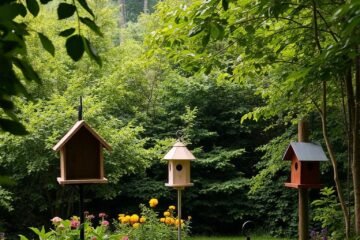
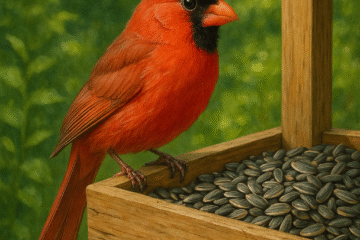
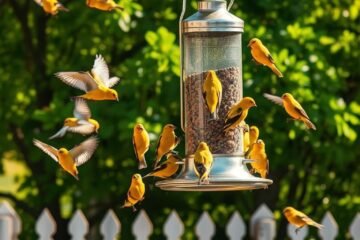
0 Comments